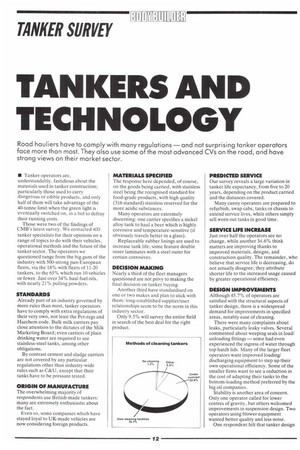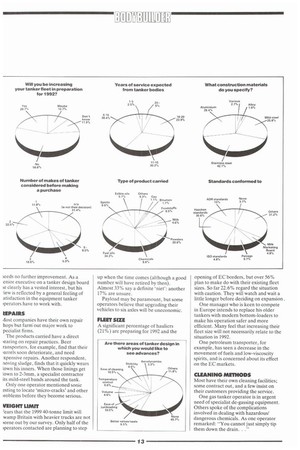TANKERS AND TECHNOLOGY
Page 112

Page 113

If you've noticed an error in this article please click here to report it so we can fix it.
Road hauliers have to comply with many regulations — and not surprising tanker operators face more than most. They also use some of the most advanced CVs on the road, and have strong views on their market sector.
• Tanker operators are, understandably, fastidious about the materials used in tanker construction; particularly those used to carry dangerous or edible products, and only half of them will take advantage of the 40-tonne limit when the green light is eventually switched on, in a bid to defray their running costs.
Those were two of the findings of CMB's latest survey. We contacted 400 tanker specialists for their opinions on a range of topics to do with their vehicles, operational methods and the future of the tanker sector. The operators we questioned range from the big guns of the industry with 500-strong pan-European fleets, via the 18% with fleets of 11-20 tankers, to the 65% which run 10 vehicles or fewer. Just over 34% haul fuel oils, with nearly 21% pulling powders.
STANDARDS Already part of an industry governed by more rules than most, tanker operators have to comply with extra regulations of their very own, not least the Pet-regs and Hazchem code. Bulk milk carriers pay close attention to the dictates of the Milk Marketing Board; even carriers of plain drinking water are required to use stainless-steel tanks, among other obligations.
By contrast cement and sludge carriers are not covered by any particular regulations other than industry-wide rules such as GiU, except that their tanks have to be pressure tested.
ORIGIN OF MANUFACTURE The overwhelming majority of respondents use British-made tankers: many are extremely enthusiastic about the fact.
Even so, some companies which have stayed loyal to UK-made vehicles are now considering foreign products. MATERIALS SPECIFIED The response here depended, of course, on the goods being carried, with stainless steel being the recognised standard for food-grade products, with high quality (316 standard) stainless reserved for the more acidic substances.
Many operators are extremely discerning: one carrier specifies a nickel alloy tank to haul a beer which is highly corrosive and temperature-sensitive (it obviously travels better in a glass).
Replaceable rubber linings are used to increase tank life; some feature double inner laminates with a steel outer for certain corrosives.
DECISION MAKING Nearly a third of the fleet managers questioned are not privy to making the final decision on tanker buying.
Another third have standardised on one or two makes and plan to stick with them: long-established supplier/user relationships seem to be the norm in this industry sector.
Only 9.5% will survey the entire field in search of the best deal for the right product. PREDICTED SERVICE Our survey reveals a large variation in tanker life expectancy, from five to 20 years, depending on the product carried and the distances covered.
Many canny operators are prepared to refurbish, swap cabs, tanks or chassis to extend service lives, while others simply sell worn out tanks in good time.
SERVICE LIFE INCREASE Just over half the operators see no change, while another 34.6% think matters are improving thanks to improved materials, designs, and construction quality. The remainder, who believe that service life is decreasing, do not actually disagree; they attribute shorter life to the increased usage caused by greater operational efficiency.
DESIGN IMPROVEMENTS Although 45.7% of operators are satisfied with the structural aspects of tanker design, there is a widespread demand for improvements in specified areas, notably ease of cleaning.
There were many complaints about leaks, particularly leaky valves. Several commented about weeping seals in load/ unloading fittings — some had even experienced the ingress of water through top hatch lids. Many of the larger fleet operators want improved loading/ discharging equipment to step up their own operational efficiency. Some of the smaller firms want to see a reduction in the cost of adapting their tanks to the bottom-loading method preferred by the big oil companies.
Stability is another area of concern. Only one operator called for lower centres of gravity, but others welcomed improvements in suspension design. Two operators using blower equipment wanted better quality and less noise.
One respondent felt that tanker design weds no further improvement. As a enior executive on a tanker design board re clearly has a vested interest, but his iew is reflected by a general feeling of atisfaction in the equipment tanker pperators have to work with.
tEPAIRS /lost companies have their own repair hops but farm out major work to pecialist firms.
The products carried have a direct Pearing on repair practices. Beer ransporters, for example, find that their Panels soon deteriorate, and need xpensive repairs. Another respondent, noving sludge, finds that it quickly wears lown his inners. When those linings get [own to 2-3mm, a specialist contractor its mild-steel bands around the tank. Only one operator mentioned sonic esting to locate 'micro-cracks' and other problems before they become serious.
NIGHT LIMIT zears that the 1999 40-tonne limit will wamp Britain with heavier trucks are not Porne out by our survey. Only half of the Pperators contacted are planning to step up when the time comes (although a good number will have retired by then). Almost 33% say a definite `niet' : another 17% are unsure.
Payload may be paramount, but some operators believe that upgrading their vehicles to six axles will be uneconomic.
FLEET SIZE A significant percentage of hauliers (21%) are preparing for 1992 and the opening of EC borders, but over 56% plan to make do with their existing fleet sizes. So far 22.6% regard the situation with caution. They will watch and wait a little longer before deciding on expansion.
One manager who is keen to compete in Europe intends to replace his older tankers with modern bottom-loaders to make his operation safer and more efficient. Many feel that increasing their fleet size will not necessarily relate to the situation in 1992.
One petroleum transporter, for example, has seen a decrease in the movement of fuels and low-viscoscity spirits, and is concerned about its effect on the EC markets.
CLEANING METHODS Most have their own cleaning facilities; some contract out, and a few insist on their customers providing the service.
One gas tanker operator is in urgent need of specialist de-gassing equipment. Others spoke of the complications involved in dealing with hazardous/ dangerous chemicals. As one operator remarked: "You cannot just simply tip them down the drain. . ."








































































































































